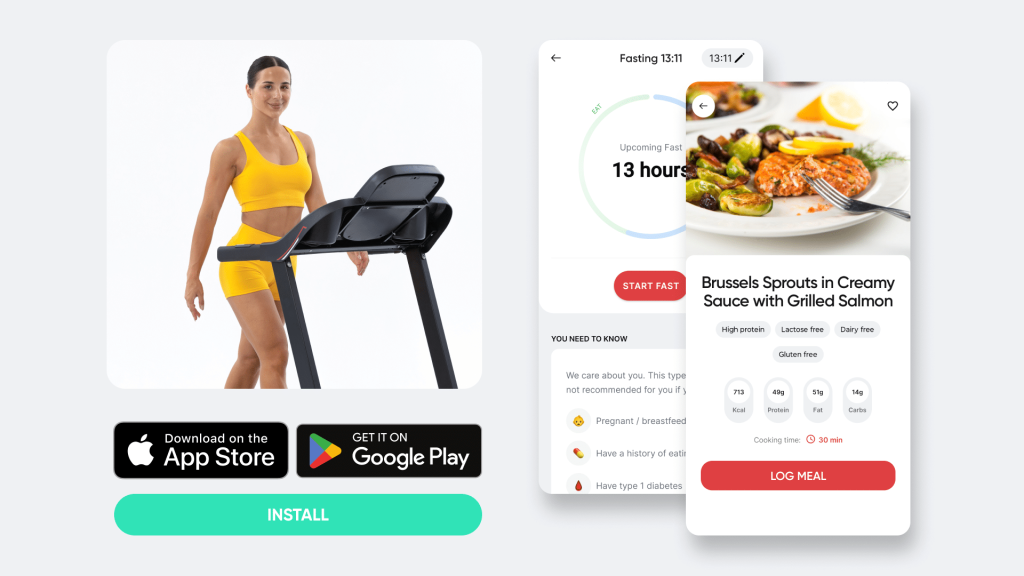The purported benefits of time-restricted feeding are well documented; cell-renewing, energy-boosting, and fat-burning, to mention just a few.
Yet not everyone can go long stretches without consuming a morsel or sip of something more substantial than water. For those individuals, dirty fasting is promoted as a more forgiving alternative.
The simplest way to think of dirty fasting is intermittent fasting with a slight bending of the rules, allowing for low-calorie drinks and snacks during the fasting window. With the right approach, it can be an effective method for weight loss and improved health.
However, if you’re making any of these six common dirty fasting mistakes, they will hinder your progress and get in the way of your success.
What Is an Example Of a Dirty Fast?
An example of a dirty fast could look something like this: you start your day with a cup of dirty fasting coffee with a splash of milk or a squirt of zero-calorie sweetener. You then proceed to not consume any food or other beverages, except for water, until your designated eating window.
You might also allow yourself a diet soda or a piece of sugar-free gum throughout the day, if the cravings get intense.
The idea behind dirty fasting is all about balance and flexibility. It’s not as strict as traditional fasting, but still encourages you to maintain control over your eating habits.
This kind of fasting is meant to work by putting your body into a semi-fasted state, where it might still be able to reap some of the benefits of complete fasting, but without the extreme restriction.
It’s sort of like taking a shortcut. You’re still on the road to fasting benefits, but you’re allowing yourself a bit of leeway to make the journey more manageable, as there are negligible dirty fasting side effects.
BetterMe app is a foolproof way to go from zero to a weight loss hero in a safe and sustainable way! What are you waiting for? Start transforming your body now!
Will I Still Lose Weight On a Dirty Fast?
Can you still lose weight dirty fasting? Yes, you can have success with dirty fasting, especially when you grasp the principle of calorie deficency. No matter how you spin it, weight loss ultimately comes down to consuming fewer calories than your body uses (1).
With dirty fasting you’re still limiting your daily calorie intake by restricting when you eat. By allowing yourself low-calorie or zero-calorie drinks and snacks during the fasting window, you’re not providing your body with a significant amount of energy to work with.
As a result, your body has to dip into its stored energy reserves (i.e., your body fat) to keep functioning, which can lead to weight loss.
If you’re not losing weight on a dirty fast, you might be falling into one of the common errors. You might be making one of these 6 mistakes:
Mistake 1: Misjudging Your Caloric Intake
Even if you’re only consuming low-calorie or zero-calorie items during your fasting window, you might still be underestimating your overall daily caloric intake.
Drinks, condiments, and gum – even if they are labeled as “zero-calorie” – can contain up to 4 calories per serving according to FDA rules.
Over the course of a day, these small amounts add up, leading to a smaller-than-expected calorie deficit or even a surplus. Always be aware of everything you’re consuming.
Mistake 2: Over-Reliance on Artificial Sweeteners
Artificial sweeteners may boast zero calories, but they can stimulate your appetite, leading to increased calorie consumption when you do eat (3).
In addition, artificial sweeteners might affect the composition of the gut microbiota, possibly contributing to issues such as bloating and discomfort (2). If you’re sweetening dirty fasting drinks or snacks, have this potential trap in mind.
Mistake 3: Adding Too Many Healthy Ingredients
Just because something is healthy doesn’t mean you should eat it in unlimited quantities during a dirty fast. Many so-called “healthy” foods are still calorie dense and could be interfering with your calorie deficit if you’re eating too much of them. Examples include nut butters, nuts, smoothies, and full-fat dairy foods.
According to the United States Department of Agriculture, one tablespoon of peanut butter contains 94 calories, a serving of walnuts contains 185 calories, and 8 ounces of full-fat yogurt contains 149 calories (5) (7) (4).
These can easily add up to a substantial calorie intake over the course of the day, even if you’re using these ingredients in small amounts.
Mistake 4: Using Dirty Fasting as an Excuse to Eat Unhealthy Foods
Just because you’re allowing yourself zero-calorie snacks during a dirty fast doesn’t mean you should be reaching for the junk food.
The “dirty” in dirty fasting refers to the fact that you’re consuming calories of some kind during the fasting window, not that you could be loose and liberal with your eating habits.
Even during your eating window the principles of healthy eating should still apply. Choose whole, minimally processed foods most of the time and reserve any treats for special occasions. Our 21-day fasting diet post has a healthy detailed meal plan.
Mistake 5: Not Drinking Enough Water
While dirty fasting allows for some flexibility with the beverages you can consume, you shouldn’t neglect your water intake. Not only does hydration play a vital role in overall health, but it also helps maintain satiety and can help to curb cravings (6).
Think of it this way; If you’re dehydrated, your body’s natural response is to crave something that provides it with hydration.
Unfortunately, when it’s thirsty, the body often isn’t discerning enough to differentiate between a sugary soda and a glass of water. If you don’t give your body what it needs in terms of water, it might look for other sources that are not beneficial to your health, or your weight loss goals.
Read more: Is Vegan Intermittent Fasting the Right Choice for You?
Mistake 6: Not Eating Enough During Your Eating Window
At its very core, dirty fasting is a form of intermittent fasting (IF), which works by restricting your eating window.
Many people struggle to make the most of this restricted time, not consuming enough food during their designated meal times.
What then happens is:
- Your body isn’t getting all the nutrients it needs from food,
- You’re not providing your body with sufficient energy to get through the day, and
- Your body is unable to produce enough of the satiety hormone leptin so that you won’t be tempted to snack between meals.
Ultimately this can lead to over-eating during your eating window (which could sabotage any calorie deficit) or snacking between meals.
Ideally, you should eat to the point of satiation when you do eat. This way your body will get the nutrients it needs and your hunger will be satisfied until the next meal time comes around. Know how many calories you need each day, and plan your meals accordingly.
Looking for an intermittent fasting meal plan example? We’ve got you covered in our low-carb intermittent fasting article.
How Many Calories Is a Dirty Fast?
The number of calories you consume during a dirty fast largely depends on what you choose to consume during your fasting window. Generally, the goal is to keep calorie intake minimal during the fasting period (i.e., no more than 50-200 calories).
Let’s break this down:
Zero-Calorie Drinks: Technically, these should have less than 5 calories per serving, according to FDA guidelines. If you’re drinking several diet sodas, coffee with artificial sweeteners, or cups of tea with a splash of milk throughout the day, these calories can add up, but they’re unlikely to exceed a few dozen calories.
Low-Calorie Snacks: If you’re consuming items like a piece of fruit, celery sticks, or a handful of almonds, these could add anywhere from 50 to 200 calories to your daily intake depending on the portion size.
“Hidden” Calories: Remember that items labeled “zero-calorie” can contain up to 4 calories per serving. Over a day, these can add up, especially if you’re a heavy consumer.
In a nutshell, if you’re dirty fasting responsibly, you’re likely consuming a few dozen to a few hundred calories during your fasting window. Note that the majority of your calories should still come from your eating window.
If you are consuming a significant number of calories during your fasting period, you might not be truly fasting. Stick to the fundamentals: maintain an overall calorie deficit for weight loss, choose nutritious foods for your meals, and ensure that your fasting period is primarily just that – a time of fasting.
What Can I Eat During a Dirty Fast?
The following are ok to eat and drink during a dirty fast:
Non-Caloric Beverages: These include water, black coffee, herbal tea, sparkling water, and other drinks with no added sugars or milk.
Low-Calorie Foods: A piece of fruit, raw vegetables like celery or cucumber, or a small handful of nuts can be consumed.
High-Protein Snacks: A hard-boiled egg or a slice of turkey breast in small portions can help to curb hunger without breaking your fast too much.
Avoid these foods during a dirty fast:
High-Sugar Foods: Foods such as cookies, pastries, and candy should be avoided, even though they might seem like convenient snacks.
High-Calorie Beverages: This includes soda, fruit juice, smoothies, and coffee drinks with milk and sugar.
Processed Snacks: Chips, crackers, and other ultra processed snacks can add unnecessary calories and lead to overeating.
BetterMe app will kick you out of the mental funk, shake off your extra weight, rid you off your energy-zapping habits, and help you sculpt the body of your dreams. Intrigued? Hurry up and change your life for the better!
Frequently Asked Questions
What Is the Hardest Fasting?
The hardest type of fasting is arguably the Absolute Fast, also known as a Dry Fast. This type of fasting involves abstaining from all food and liquids, including water, for a set period of time.
The duration can vary, but it often lasts for 24 hours, though some people may pursue a dry fast for up to 36-72 hours. This type of fasting should be done under strict medical supervision due to the risk of severe dehydration.
How Much Weight Will I Lose on a 3 Day Water Fast?
On average, people tend to lose between 2 to 5 pounds on a 3-day water fast. Much of this weight loss is due to water loss and the depletion of glycogen stored in the liver and muscles. Therefore, a lot of the weight can return once you resume your normal eating habits.
What Is Forbidden to Do While Fasting?
While fasting, it’s usually forbidden to consume most types of food and drinks, particularly those with calories. This includes solid foods, sodas, juices, milk, smoothies and alcohol. Drinking water, black coffee and tea without milk or sugar are typically allowed in most fasts.
In addition to food and drink restrictions, it’s also recommended to avoid strenuous physical activity due to the potential for fatigue and dizziness. Unhealthy behaviors such as smoking are also usually discouraged during a fasting period.
The Bottom Line
Dirty fasting may be more lenient than “true” fasting methods, but it still requires careful planning if you want to make the most of it. Pay attention to all these potential pitfalls and you’ll give yourself the best chance of reaping the benefits of this popular weight-loss strategy.
Remember, dirty fasting is just one tool in the weight loss arsenal and should be used in combination with other healthy lifestyle choices such as regular exercise, adequate sleep, and stress relief.
When you make these positive changes to your health routine you will increase your chances of achieving a sustainable weight loss plan that lasts.
DISCLAIMER:
This article is intended for general informational purposes only and does not serve to address individual circumstances. It is not a substitute for professional advice or help and should not be relied on for making any kind of decision-making. Any action taken as a direct or indirect result of the information in this article is entirely at your own risk and is your sole responsibility.
BetterMe, its content staff, and its medical advisors accept no responsibility for inaccuracies, errors, misstatements, inconsistencies, or omissions and specifically disclaim any liability, loss or risk, personal, professional or otherwise, which may be incurred as a consequence, directly or indirectly, of the use and/or application of any content.
You should always seek the advice of your physician or other qualified health provider with any questions you may have regarding a medical condition or your specific situation. Never disregard professional medical advice or delay seeking it because of BetterMe content. If you suspect or think you may have a medical emergency, call your doctor.
SOURCES:
- Calorie Deficit: What To Know (2022,clevelandclinic.org)
- Effects of Sweeteners on the Gut MicrobiotA Review of Experimental Studies and Clinical Trials (2019,nih.gov)
- Gain weight by “going diet?” Artificial sweeteners and the neurobiology of sugar cravings (2010,nih.gov)
- Nuts, walnuts, english (2018,usda.gov)
- Peanut Butter (2019,usda.gov)
- Water and Healthier Drinks (2022,cdc.gov)
- Yogurt, plain, whole milk (2018,usda.gov)









